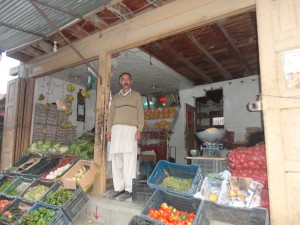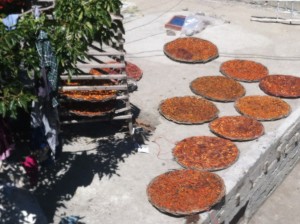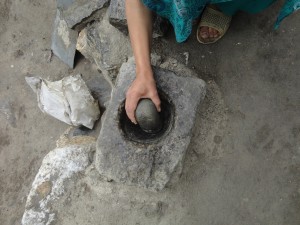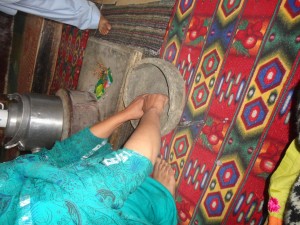PROPOSAL:
My major concern is the preservation of the social and cultural heritage of the people of Hunza by providing them with assistance to utilize and benefit from their own natural resources. My research topic is the apricot grown in the Hunza valley.
In my recent visit to the Hunza valley during August 2014, I spent most of my time interacting with the locals along with meetings at the local council and other active organizations there. Every place I visited, in particular the site of the newly formed Attabad Lake and its landslide affected people, I observed many interesting things about the place. Apart from being struck by the compelling beauty, mountainous landscapes, lush orchards, I realized that the people were most hospitable and kind.
Unfortunately, some of them had suffered the terrible natural disaster: the landslide in Attabad, which almost demolished three villages, displacing many households and causing numerous deaths.
The effects of the after-math were not only the loss of housing – swallowed by the ensuing lake – but of lifestyle. That caused a major setback to the socio-economic position: from a self-sufficient people to the status of internally-Displaced-Persons.
Interestingly, Hunza valley ties Pakistan with China at the Khunjarab Pass. It thus serves as a junction not just for visitors but also for one unsurpassable trade route. Here is the chance for cultural and social intermingling. It is important to engage these IDPs – of the Attabad Lake disaster – in a process of rehabilitation that may help them resettle and re-engage into their system of life, with minimum alterations, before their previous identities are completely transformed.
To me, the fruit in Hunza is the real jewel of the valley. The exquisite apricot is at the head of the list. Here in Hunza one can see the apricot been laid to dry on the roof of nearly every house. Apricot alone has an immense amount of potential. Naturally packed with many nutrients, having great medicinal properties, and of course delicious to taste, makes it a favorite.
Hunza is blessed with about twelve to fifteen varieties of this fruit. Only forty percent of that is utilized while the remaining sixty percent plainly wasted. This usually happens due to poor protection of the fruit at the point of reaping. Some of the fruit never sees its way down to the market due to inadequate transportation down to the plains, and poor packing engendering the fermentation.
What measures can we take for the arising problems? Not enough products are being made to consume and maximize the usage of this precious fruit.
There are plenty of ways and production ideas to choose from. But we must choose those that favor the local environment and society. During this research I discovered that the “Red Zone” areas of Sarat and Attabad still had some agricultural land but people either refuse to budge or go back to this cultivable land for lack of money. There is the proposal to utilize these areas as communal farming zones where apricot trees may be planted, densely, not just to hold land from sliding into the river but also to provide affected people with some farming-work opportunity – helping themselves to get back to normality in life.
Another idea is to establish small setups that produce organic apricot jam, chutney, and pickle. One popular apricot product is its oil, extracted from the kernel. Beauty products like handmade soap, body-lotion, cream and balm can be the by-products. Made of natural ingredients these can quickly make a niche among the beauty-conscious masses in the plains, and elsewhere.
Hunza is a unique place blessed with the abundance of nature and beautiful people who have a deep connection with their land evident from their history and customs. It is important for the people of this valley to be able to benefit from their cultivation in more ways than already undertaken. Providing opportunity to the flood affected people of Attabad to rebuild their own lives is of the utmost importance. Economic stability in the region would strengthen not only the household but also shield it from cultural intrusion that might affect its centuries old value system and heritage. Lastly, these people need to share the gifts they have been endowed with by nature with the rest of the country, and subsequently the world.
Background
The valley of Hunza-Nagar is located in Gilgit-Baltistan, the northern-most region of Pakistan. It is located about 8,200 feet above sea level and borders China. The Khunjerab Pass links Pakistan to the Xinjiang province of China. The renowned Karakorum Highway not only links China to Pakistan but this valley to the rest of the country. The valley is beautiful, scenic and home to one of the highest mountain peaks in the world.
The history of Hunza is perhaps as old as the history of the Silk Route itself – so does a UNESCO Heritage site at Genish tell us. Once a princely state, the valley had been under Buddhist influence before the advent of Islam, traces of which can be seen in the engravings and drawings on rocks – locally still perceived as sacred rocks. Due to its location, a transit city connecting trade routes in Asia and Europe, Genish had its own significance. But serving as a transit route for Europe and Asia also opens up this valley to socio-cultural invasion apart from the benefit it enjoys in trading.
Therefore Hunza makes itself vulnerable to cultural intrusion. The valley today still serves as a major and important trade route. This may also be of concern nowadays since it is has become easier to takeover, culturally, due to our modern devices and mediums, that have surely accelerated that process of change, promising a penetration and infusion more vigorous than ever. Naturally, the dominant culture does always take the place of that which becomes subservient. Hence it is important to attempt to protect and preserve the social and cultural values of the people in the Hunza valley.
The valley still holds an important strategic position for Pakistan.
In order to make use of that, people need to strengthen their economy by taking full benefit of the resources nature has bestowed upon them. Also, it is important to work for the rehabilitation and resettlement of the flood affected population of the Attabad Lake. The flooding, because of the landslide, in 2010, submerged nearly three villages and disconnected Upper Hunza (Gojal) from the rest of the valley. Nearly 12 miles of the Karakorum highway was inundated by the newly formed lake as was the land and the houses of the villagers of Attabad, Shishkat, Sarat, Ayeenabad and Gulmit. This disaster not only displaced people but also resulted in the loss of their cultivable land, lifestyle and occupation.
Four years on they are living the life of IDPs in camps close to Altit and Gulmit. Few, whose land still exists in the red zone do not have the means to go back and visit their lands. From being once self-sufficient, these people have fallen to ones suffering from an identity crisis due to the complete transformation of their socio-economic position.
On our visit to the Hunza valley under the “Laajverd Visiting School” in August 2014, we worked on individual research projects. The aim was to understand and work in ethical parameters in favor of the local population. Interacting with the locals in order to gather holistic information regarding the tastes and environmental preferences of the people did also place us to in a position where we got to know most problems these people have had to face. This was enabled by pre-arranged meetings with the local NGOs, and then with other representative bodies such as FOCUS, AKCSP and the local and regional council. The information these bodies provided us with was very helpful in understanding the dynamics at work in the valley.
After close examination of the region, we developed an interest in fruit farming that this valley is blessed with. In particular, the apricots here are exquisite and have an exceptionally good flavor. These can surely compete with the best apricots in the world. Unfortunately, a good percentage of these never sees its way to the market.
Our report therefore focuses on apricot farming and its utilization in various ways.
About the Apricots grown in Hunza and how they are used locally
The apricot fruit in Hunza is most abundant. One finds the fruit growing at large in orchards and trees along pathways. The fruit is eaten fresh and is used in the dried form as well. It is used in local recipes such as the Chamooz – a local juice made of dried pulp. This dry fruit is also used in making soups and the kernel paste is used as a base in many local dishes.
There are two ways of drying the apricot, one method is completely organic and does not involve any chemical treatment. The natural way is to de-seed the fruit and let it dry under the sun for nearly 10-15 days depending on the time the fruit takes to lose its moist. The ideal time to dry the apricots is between July and august when the sun is sharp and there is less moisture in the atmosphere. The second method involves the usage of sluphur to dry the apricots. This is done in a similar manner but the fruit is kept in a basket lined with sulphur dioxide powder and the baskets are covered with a plastic sheet. The usage of sulphur retains the natural color of the fruit and keeps it soft. This process also leads to a longer shelf life. Whereas sundried apricots lose their natural tawny color and are free of any sorts of preservatives. Therefore the sulphur dried fruit is packed to be sold commercially but the locals keep the sundried apricots for personal use. One can see the drying process on the roofs of almost every house in Hunza valley.
 Information source/Local fruit & vegetable shop in Hunza
Information source/Local fruit & vegetable shop in Hunza
Dried apricot is sold all over the country. It is also exported to U.S.A, Italy, Germany and china. The fresh fruit is utilized locally. Some is sold within the neighboring areas but most of the fruit due to poor packaging and lack of refrigeration cannot be exported or sold in the plains.
Market selling price of fresh apricot (Aug ’14)
(Data collected from “Hunza Itifaq Sabzi” Aliabad,Hunza)
- White apricot Rs 80 per kg
- Red apricot Rs 60 per kg
Whole sale market rate of dried apricot (Aug ’14)
(Data collected from whole sale shops at Aliabad and Kareem Uddin, shopkeeper at Baltit fort road, Hunza)
- Natural sundried, Rs 250-300 per kg
- Sulphur dried,
- white (A- quality)Rs 300 per kg
- Lal(red) (A-quality) Rs250 per kg
- Others between Rs 200-150 per kg
Types of Apricots:
There are nearly more than twelve to fifteen types of apricots growing in the region. The most popular verities are
- Sikhanda
- Alishakakas
- Habbi
- Brumju (white apricot)
- Dodor
- Surias sumjh
The apricot ripping season is between March and July. By May, the fruit is ready but has not fully ripened. A single tree produces nearly 60-70 kg (one man) of fresh fruit from nearly 1000kg of fresh apricot and 200-350 kg of the dried fruit is obtained.
Apricot kernel oil is another popular by-product.and is widely used for various purposes such as food, medicine and ointments, drugs, soaps and creams. It comes in two types
- Bitter
Whole sale market price (Aug ’14) is Rs 300 per kg
- Sweet :
Whole sale market price (Aug ’14) is Rs 400-450 per kg
Traditionally the extraction of the oil was done in a stone basin. the kernels were first grounded in a mortar and pestle then in a warm stone basin the grounded seeds are hand pressed with little water until it forms into a pasty dough. Afterwards the dough is heated so that all the oil comes out of the paste.
Oil being made the traditional way
But now the oil extraction machines are located in nearly every village which extracts the oil in no time. The oil is then sealed and packed to be sold or exported.
BENEFITS OF THE FRUIT
Known by the scientific name of Prunus Aremenaica, apricots were first grown in China and through Silk Route trading and commerce reached Europe and other part of the world. Apricots are packed with vitamin C and A. They are also rich in fiber and in anti oxidants. Being rich in fiber improves digestive health. The nutrients present helps in prevention from disease like cancer and improves heart health, cures asthma.
A single, fresh apricot of an average size provides you with 4.6% of Vitamin C, 3.7% of Vitamin A, 3.3% of Copper, 2.7% of Fibers, 2.5% of Potassium and just 17 calories. A nutritional table below will give you a detailed analysis of the nutritional value of the fruit.
Apricot is also a favorite beauty fruit. It has anti aging properties due to anti oxidants and vitamin present in it. Apricot oil moisturizes the skin and is core ingredient in many beauty products such as soaps, creams, moisturizer, lotions, shampoos and conditioners. The oil is also ideal for massage because it’s absorbent qualities. The oil is mild and not irritating to the skin. It is also a suitable oil to massage children and babies.
How to make the most of Hunza apricots?
The subject of our research focuses on the “apricot farming and utilization of the fruit” grown in Hunza valley. While visiting the valley in August, we came to know that nearly sixty percent of the fruit gets wasted in one or the other way. And only forty percent comes under use. Where does the fruit go? From the forty percent, the fruit is either eaten fresh or is dried to be sold or kept for domestic use. The kernel is used to make the oil. A very small percentage is exported and the rest is used locally. The by-product of the kernel is used as fodder for the cattles. Some of the fruit is packed to be sold, but most of the fruit is unable to reach down to the masses. Because there no proper refrigeration units that can keep the fruit fresh on its way down. Ideal refrigeration is needed because the apricots grown in Hunza are very delicate and has a thin skin therefore harsh weather conditions can damage them easily.
We see a great potential in Apricot farming and its product manufacturing. That can help to strengthen and support various households in Hunza valley.
Can we help empower the women by creating opportunities and support to regenerate the livelihoods of the Attabad flood affected families?
Outlined below are few proposals to derive maximum benefits from this single wonder packed fruit.
- Improve packaging and introduce refrigerated storage and special transportation system with temperature control. The fragility of the fruit should be kept in mind before roughly tossing the fruit in a container. Soft natural packages should be designed, using local material such as dried plants and soft barks that can provide a pliable support.
- There should be a detachable hammock like structure that works like a basket, holding the apricots that fall from the tress by wind or delayed picking. We can minimize the chance of the fruit getting rotten.
- The red zone areas near the Lake Attabad can be densely planted with the apricot trees, to make them become communal farming zone for the IDP’s. The plantation may help in holding the land and prevent it from landslide. And on the other hand open up an enterprise where the displaced families could work and make use of their lands. Also generate a stable source of income which would assist them in rebuilding their previous lifestyle.
- The establishment of small cottage industries for producing Apricot related food products such as jams, chutney, pickels and infused tea’s and juices.
- Along with organic beauty products like soaps, creams, lotions, scrubs and face wash will be manufactured using local ingredients.
This exercise will not only be helpful in strengthening the economy of the region but this stability will protect them from any cultural intrusion and preserve their century’s long traditions and heritage. It will also provide the people of Hunza to share the natural gifts they have been bestowed with the world.




